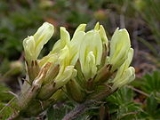
Oxytropis campestris
Encyclopedia
Oxytropis campestris is a plant native to the Northwestern United States and all Canada, sometimes grown as an ornamental plant
.
It is found in prairies, woods, and meadows, and prefers gravelly and rocky slopes, where it grows most abundantly. The plant has numerous variants.
. The actual flowers have five lobes and form a calyx tube. They are of a cream to yellowish color, but sometimes of pink, blue, or purple, with hairs that are usually black. The keel petals are pointed, and often have purple blotches.
The plant also produces fruit which matures from July to September. These are legumes which are oblong-ovate 1.5 to 2 cm in length. They are mostly sessile
and dehiscent
from the tip. The fruit has membranous and contains many seeds.
The plant grows perennially, with an acaulescent forb
reaching 20 to 50 cm in height and has a taproot.
Leaves grow alternately in a pinnate
fashion and are usually 8 to 40 cm long. The leaves are dimorphic, with primary leaves short ovate leaflets, and secondary leaves with 11 to 33 leaflets. These secondary leaflets are 1 to 2.5 cm long.
. It is federally listed as a threatened species of the United States.
Ornamental plant
Ornamental plants are plants that are grown for decorative purposes in gardens and landscape design projects, as house plants, for cut flowers and specimen display...
.
It is found in prairies, woods, and meadows, and prefers gravelly and rocky slopes, where it grows most abundantly. The plant has numerous variants.
Description
Oxytropis campestris blooms flowers from May to July. These are racemes that are capitate or oblong, 4 to 15 cm in length. The plants have 8 to 32 flowers that rise from a scapeScape (botany)
In botany, scapes are leafless flowering stems that rise from the ground. Scapes can have a single flower or many flowers, depending on the species....
. The actual flowers have five lobes and form a calyx tube. They are of a cream to yellowish color, but sometimes of pink, blue, or purple, with hairs that are usually black. The keel petals are pointed, and often have purple blotches.
The plant also produces fruit which matures from July to September. These are legumes which are oblong-ovate 1.5 to 2 cm in length. They are mostly sessile
Sessility (botany)
In botany, sessility is a characteristic of plants whose flowers or leaves are borne directly from the stem or peduncle, and thus lack a petiole or pedicel...
and dehiscent
Dehiscence (botany)
Dehiscence is the opening, at maturity, in a pre-defined way, of a plant structure, such as a fruit, anther, or sporangium, to release its contents. Sometimes this involves the complete detachment of a part. Structures that open in this way are said to be dehiscent...
from the tip. The fruit has membranous and contains many seeds.
The plant grows perennially, with an acaulescent forb
Forb
A forb is a herbaceous flowering plant that is not a graminoid . The term is used in biology and in vegetation ecology, especially in relation to grasslands and understory.-Etymology:...
reaching 20 to 50 cm in height and has a taproot.
Leaves grow alternately in a pinnate
Pinnate
Pinnate is a term used to describe feather-like or multi-divided features arising from both sides of a common axis in plant or animal structures, and comes from the Latin word pinna meaning "feather", "wing", or "fin". A similar term is pectinate, which refers to a comb-like arrangement of parts...
fashion and are usually 8 to 40 cm long. The leaves are dimorphic, with primary leaves short ovate leaflets, and secondary leaves with 11 to 33 leaflets. These secondary leaflets are 1 to 2.5 cm long.
Toxicity
The Oxytropis campestris plant is poisonous and may cause loco disease in livestock. From this it derives the common name field locoweed or some other variations. It is therefore worthless as food and is consumed only when other forage is not available.Conservation
Though this plant is common in general, one variety, var. chartacea, is a rare taxon limited to two counties in the state of WisconsinWisconsin
Wisconsin is a U.S. state located in the north-central United States and is part of the Midwest. It is bordered by Minnesota to the west, Iowa to the southwest, Illinois to the south, Lake Michigan to the east, Michigan to the northeast, and Lake Superior to the north. Wisconsin's capital is...
. It is federally listed as a threatened species of the United States.

